#History of Magic
Text
Draco Malfoy x y/n (Slytherin Reader) one shot
SUMMARY: Draco relentlessly flirts with y/n even if it annoys her.
WARNING: none other than the fact that this is not proof read.

It was late afternoon after lunch break and Y/n was noting down points on a piece of parchment while professor Prof.Binns went on droning about the 'Medieval Assembly of European Wizards'. Most students find History of Magic to be exasperating but it's mostly because of Prof.Binn's teaching techniques.
Regardless of how boring it may seem, y/n makes it a point to give her 100% in class. She was concentrating so sincerely that she failed to notice a certain platinum haired boy glancing her way every few minutes. As the class went on, Prof. Binns decided to halt the lecture to let the students read and review the material before proceeding further . As she continued to read through her textbook, a charmed paper swan flew over her head and landed right on the page she was reading. She looked up and around to see who levitated it towards her and saw the group of infamous Slytherins laughing- Malfoy, Zabini, Parkinson , Nott, Crabbe and Goyle. She immediately knew it was their doing. Draco was waiting for her to look in his direction and now that she did he winked at her and shouted across the class " go on darling, read it" ; only for his friends to howl and make funny noises. Y/n got irritated so she rolled her eyes at him and grabbed the paper swan to crush it into a paper ball and chuck it at him. Soon the class ended but only after Prof.Binns had given them an essay as homework.
Y/n slung her bag on her shoulder and carried her extra books with her arms & exited the classroom to head to the courtyard since it was her last lecture of the day. Draco immediately followed her out of the class to catch up and annoy her. "Uff, that looks heavy; lemme carry them for you sweetheart" he tries to snatch the books in her arms. Y/n gets irritated " Don't you have somebody else to bother Malfoy?". "Actually, I do but you're far more interesting and also pretty cute to look at" he replies with a grin and tries to snatch her books again. This time y/n stops in her tracks and pulls Draco down by his tie to look into his eyes "Back off Draco". This makes him grin wider and he lets out a whistle while looking her up and down " ooh... feisty". Y/n blushes at the action and immediately releases his tie and walks away while Draco just stands there grinning like a fool in satisfaction.
Later that night y/n entered back in the Slytherin common room after having finished with her dinner and decided to sit on one of the couches near the fireplace. She was reading a magazine that she found on one of the coffee tables when she felt the couch sink beside her and an arm around the back of the sofa where she sat. She immediately recognised who it was just by the smell of expensive cologne. " What do you want now Malfoy?" she said without looking up from the page. "What? Can I not just spend some time trying to make acquaintances with fellow house mates?" he mockingly replied. Y/n decided to ignore him altogether and Draco got the hint but he wasn't satisfied with the interaction just yet, so he started to play with her hair. This made y/n's blood boil and she swatted his hand away and he let out a chortle. "You have nice hair" he said. "Oh why thank you Mr.Malfoy. It's an honour to get complimented by the ferret boy with slimey hair" she replied with a sarcastic smile. Draco pulled a face at this but laughed it off. Y/n shut the magazine and stood up and walked towards the stairs leading to the girl's dormitories when she heard "Goodnight darling!". She turned the corner as she secretly smiled at his antics and yelled back "Goodnight ferret boy!"
..........................................................................................
Thanks for reading! 🤍
Sorry for any grammatical or spelling errors, this is not proof read 😅
Do like, share and comment your thoughts down below 🤔💭
#draco malfoy x reader#draco malfoy x slytherin!reader#slytherin boys#theodore nott#draco malfoy#draco lucius malfoy#draco imagine#draco fic#draco x y/n#draco x you#draco x reader#draco x oc#blaise zabini#pansy parkinson#vincent crabbe#gregory goyle#slytherpride#slytherin#slytherin gang#history of magic#professor binns#malfoy family#draco malfoy x y/n#draco malfoy fluff#draco being a flirt#flirty#hogwarts oc#hogwarts school of witchcraft and wizardry#hogwarts houses#harry potter
106 notes
·
View notes
Text



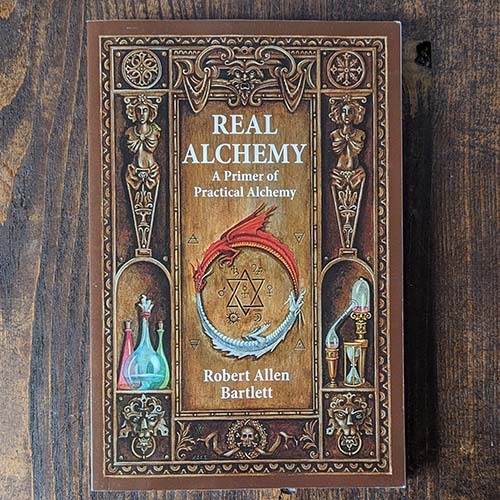


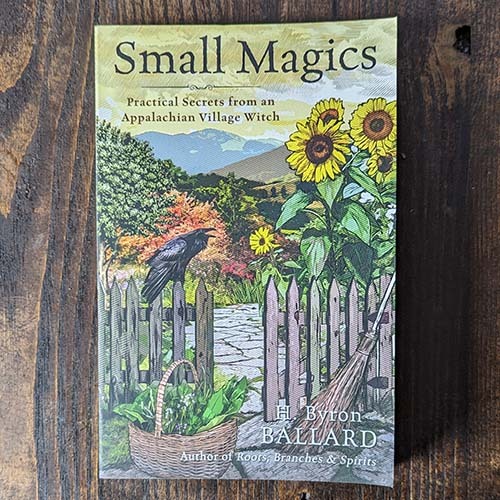



New in the Spiral House Shop!
September 29, 2023
The Long Hidden Friend by John George Hohman Edited and Illustrated by Gemma Gary
Magic: A History: From Alchemy to Witchcraft, from the Ice Age to the Present by Chris Gosden
The White Deer: Ecospirituality and the Mythic by Melinda Reidinger
Real Alchemy: A Primer of Practical Alchemy by Robert Allen Bartlet
Visual Alchemy: A Witch's Guide to Sigils, Art, and Magic by Laura Tempest Zakroff
How to Deal: Tarot for Everyday Life by Sami Main
Small Magics: Practical Secrets from am Appalachian Village Witch by H Byron Ballard
The Seed & Sickle Oracle Deck by Fez Inkwright
Crafting a Daily Practice: A Simple Course on Self-Commitment by T Thorne Coyle
The Gorgon's Guide To Magical Resistance edited by Laura Tempest Zakroff
#laura tempest zakroff#gemma gary#traditional witchcraft#appalachian witch#small magics#witchblr#tarot#alchemy#real alchemy#history of magic#white deer#witch shop#witch books#seed and sickle
207 notes
·
View notes
Text
THANK YOU SO MUCH !!!! vol.2

PLS DELETE OLD FILES (catel, DTS …, bookhp). Thank you so much for your support! report me any issues please :)
Пожалуйста, удалите старые файлы (их имена catel, DTS …, bookhp). Большое спасибо за поддержку! Пожалуйста, пишите мне о любых проюлемах :)
GRAB IT FREE SFS BOOSTY
Thank you for sharing <3
@sssvitlanz @no-habla-simlish @witchysimmers @witcheshistory @ojoquevecorazonsen @ivysccfinds
Magic realm req. for functional cauldrons!
Старые файлы выглядят так (что смотреть стыдно хаха):
Shame old preview under the cut:
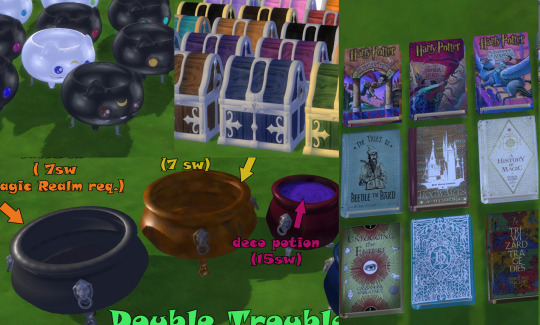
#ts4cc#ts4 download#ts4 custom content#sims 4 cc#sims4cc#ts4#sims4#sims 4 custom content#ts4 witchy content#sims4 decor#witchy#sims 4 cauldron#ts4 cauldron#cauldron#ts4 magic#ts4 magic realm#magical theory#history of magic#maxis match#sims 4 genshin impact#ts4 genshin impact#gensin impact
93 notes
·
View notes
Text

The Dance of the Witches' Sabbath: illustration from History of Magic by Jean-Baptiste Pitois —By Émile Bayard (Paris, 1870)
#Dance of the Witches#Sabbath#History of Magic#Jean-Baptiste Pitois#Émile Bayard#Paris#1870#19th century art#19th century#xix century#art#artwork#illustration#ritual#La Danse du Sabbat#Emile Bayard#Pitois's Histoire de la Magie
284 notes
·
View notes
Text
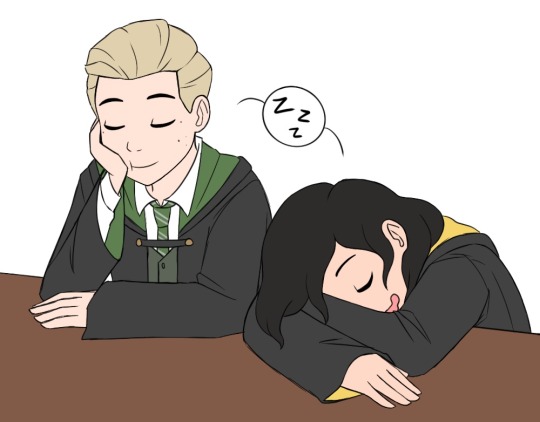
History of Magic with Ominis 🥱💤
#hogwarts legacy#hogwarts legacy fanart#hogwarts legacy mc#ominis gaunt#history of magic#lyla estaris
223 notes
·
View notes
Text
More Omi in History of Magic class
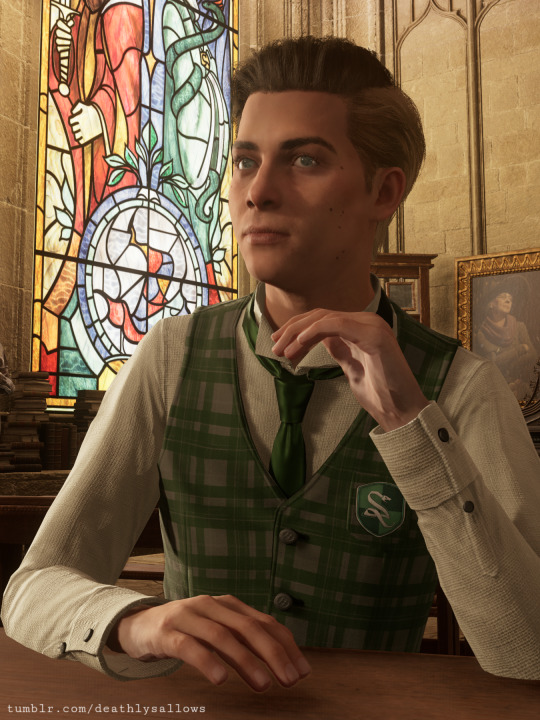







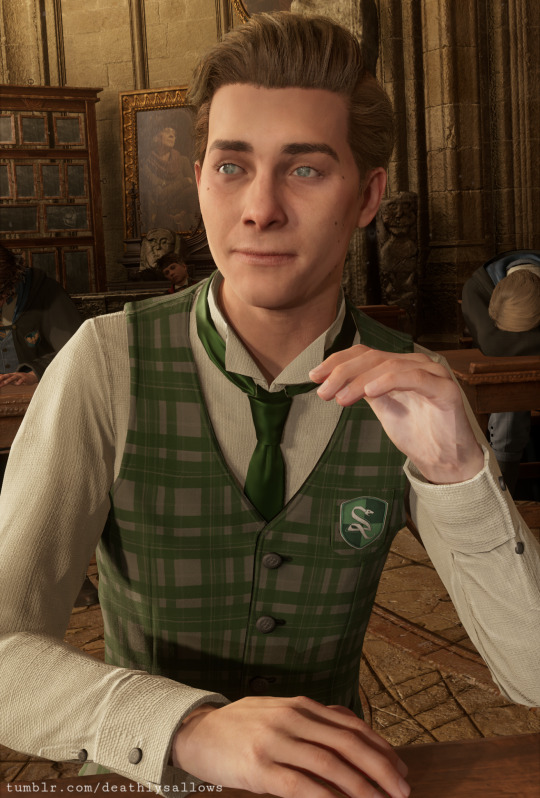

285 notes
·
View notes
Text
Shufflemancy 101: A Brief History & Analysis
Hey! If you like my work and want to support me in my quest for divination theory, digital tools, algorithmic quandries, and research into niche divination tools, consider throwing dollars at my Ko-Fi tip jar! Every contribution helps me keep making posts like this one. (You can also read this post over on Ko-Fi!)
The difficulty with researching something like shufflemancy is that it's a relatively modern phenomenon. I haven't yet found anyone (online or in a book) specifically talking about the origins of shufflemancy as a term or where it might've come from.
So, we start from square one.
What is Shufflemancy?
According to Wikipedia, shufflemancy is divination "by the use of an electronic media player such as an electronic playlist, iPod, or other medium wherein one skips a certain number of songs and the lyrics and/or tune of the song is the answer to the divinatory question."
Simple enough. Use an electronic collection of music that's been shuffled to divine.
This did lead me to the question: What counts as shufflemancy? Does tuning into a radio station count?
It's my opinion that radio divination does not count. There's no shuffle function. Yes, it has an element of chance, and that's what makes it divination. It certainly falls under the wider umbrella of divination via music, too. But it isn't shufflemancy if it doesn't make use of a shuffle function.
So, to make things simple, for something to be shufflemancy, it must:
Use an electronic medium
Involve a randomized shuffle function
Be something the shufflemancer can interpret to answer a question (pretty much anything)
Early Shufflemancy
The earliest form of shufflemancy as we understand it today, using the above requirements, would probably be tape players capable of shuffling music. With the nature of tape, it would take a while for the thing to wind and rewind to find the cue on the tape which signaled the start or end of a song, but it'd work.
With that said, shuffling as we understand and recognize it today would've started with CDs in the 1980s. There were CD players that could hold three to five disks at a time. They could shuffle songs between all disks held in the player, creating a random mix of tunes for listeners to enjoy.
Using either of these methods for divination would work, technically. The results would be somewhat limited, but that doesn't mean it's a bad method to use. Especially if your CD player could hold 5 disks, you could easily put in 5 albums from different artists with all different vibes for a wider variety of outputs.
I certainly remember using my little blue radio that held two CDs at once like this. I'd put in two albums and hit shuffle, and the first song that played would be my vibe and advice for the day. It was divination -- some of the earliest I'd ever done consciously, at the young age of nine. And when I got the bigger one that held three CDs? Game changer.
So this puts shufflemancy's origins somewhere around the mid-to-late 1980s, when Sony put out the first CD player with shuffle. As we moved into the 1990s, CDs became more popular and cassettes faced obsolescence.
The Shuffle Revolution & Early Modern Shufflemancy
In 2005, Apple changed the game again. It had already debuted the iPod in 2001, providing an easy, pocket-sized music experience as a direct challenge to the CD's cultural domination. On January 11, 2005, nearly 20 years ago, Apple announced the iPod Shuffle.
And oh, boy, did it change everything.
I could talk forever about the iPod's impact on the music industry, the death of the in-order album, and the eventual rise of music streaming services. But others have done that to death, so I'll focus in on our topic of shufflemancy.
This is where we start seeing shuffling music as it is now, in the modern day. In my digging, I found mentions of the term "shufflemancy" as early as 2007 -- just two years after the iPod Shuffle was announced. Someone proposed the concept and terminology of "shufflemancy" as we understand it today on a Halfbakery Forum "Idea" post on October 3, 2007.
It's difficult to say whether this is the first instance of the term. In reality, shufflemancy seems to have emerged as a natural by-product of the evolution of music technology. Where there is innovation, witches and diviners will mold it to their purposes. We're a resourceful bunch like that. It grew organically as we moved from buying albums to buying singles to streaming music without buying at all.
People were offering public shufflemancy readings as early as 2009 in places like TarotForum.net. It's spoken about during this era as a "silly" and "new" form of divination that people were trying out. There aren't any dates in that link, but according to the website's data, the first post in the thread was published on June 16, 2009.
From there, shufflemancy saw a gradual rise in popularity. It evolved from using iPods to iTunes, Napster, and eventually Spotify as these new applications emerged.
Shufflemancy Now
If you look up "shufflemancy" using Spotify's search function, you'll receive dozens of results. Many of the top playlists are public ones curated by shufflemancers for themselves and others to use. Options range from general playlists to "mega mixes" containing upwards of 200 hours of music from all different genres, artists, and eras. There are some with a paltry five hours of music, while one that I've seen goes up over the 600 hour mark. (If I can find that one again, I'll reblog it, because... damn.)
Select a "messages from your guides" option from the search or curate your own -- the choice is yours. For one-time shufflemancers, using a pre-made option may be the best, most economical choice. But dedicated shufflemancers sometimes boast multiple hundred-hour playlists for different purposes, all personally curated.
Clearly, it's popular. There are shufflemancers on Tumblr and Etsy offering free and paid services using their specially curated playlists. A quick search is all you need to find someone receiving a divinatory reading via song lyrics, meanings, and vibes. And it seems to work -- sellers on Etsy boast hundreds of positive reviews. Some even offer playlist curation services for personal shufflemancy or messages from deities and/or spirits.
It all begs the question, how does shufflemancy work?
Shufflemancy Methodology
Finding this is significantly easier than pinning down the history of shufflemancy. This post from Tumblr user orriculum, sums it up fairly well. So does this one by the-daily-diviner.
To do shufflemancy, the basic steps are:
Create or find a playlist of songs. A large collection seems to be the most favorable option for a wide spread of possibilities.
Ask a question. Divination 101 -- figure out what you want to know and ask it. Simple enough.
Pick a number. Choose any number and shuffle that many times or skip that many songs.
Listen to the song. Write down lyrics that stick out, messages that come through, and anything else that seems relevant (genre, tempo, vibe, etc.)
Interpret. Take the information gathered during the song and use it to draw conclusions, just like any other form of divination.
Simple enough. Shufflemancy is the sort of method that requires a high level of intuitive thinking. It's very mutable and suits a good amount of personalization.
This is both good and bad, I think. It would be incredibly easy to create a bias in your shufflemancy playlists by selecting songs with primarily one genre, artist, album, emotion, or through-line. The ideal playlist really does have a wide variety of music, and this means selecting songs that the shufflemancer doesn't necessarily like. We all have a genre or artist we hate; excluding an entire genre skews results. Impartial selections of music are critical to the success of good divination. Otherwise, we risk interfering with the outcome.
And speaking of interfering...
The Algorithm Problem
(Note: I'm focusing in on Spotify since it's very commonly used and because it's accessible to me. Shufflemancy can be (and is!) done with plenty of other apps like Apple Music.)
When Spotify was originally launched, it used a version of the Fisher-Yates Shuffle to perform its shuffling of music. In essence, this algorithm takes a finite sequence of data, picks an option from that selection of data, and removes it from the pool. Then, it picks another and another until no more options remain.
At first glance, this seems great! It creates a fairly random output. But as is the nature of randomness, there were clusters. The same artist would play four or five times in a row from a large playlist, and Spotify users complained. It was random, but it didn't feel that way.
The human brain is wired to find connections and patterns. When the same artist plays over and over again despite a playlist being on shuffle mode, it creates a pattern that the brain recognizes. Therefore, the "true" randomness of clustering outputs was unsatisfactory.
So, in 2014, Spotify updated it. Their new algorithm would detect and remember the song it just played and, in shuffling, account for the artist and album to provide a more random-feeling result. The new algorithm detects what's already played and selects accordingly to prevent the same artist from playing twice in a row, just as it prevents the same song from playing twice. It spreads artists out evenly (though not perfectly, to maintain the illusion of randomness) to provide an enhanced listening experience.
What does this mean for shufflemancy, then? If Spotify's algorithm is interfering in the output provided from a playlist, does that mean it's not a reliable form of divination?
At first, I wasn't so sure. I adjusted my thinking -- if a tarot app was preventing certain cards from being drawn (or from being drawn in a particular order) because I'd already drawn them that day or week, would that render the app unreliable? And the answer was yes. It would! It removes the random element from the method, therefore making it not true divination by my definition.
So shufflemancy with Spotify isn't (good) divination, then. Right?
My Opinion & Theory
In thinking about this further, I think it comes down to personal opinion. People certainly have success with shufflemancy via Spotify, or else they wouldn't do it. They definitely wouldn't offer their services (free or otherwise) if they weren't confident in the results it provides.
Thinking that way, I believe there's a way to off-set the algorithm's interference. With enough songs in a playlist, the random element is enhanced despite the algorithm. Not by having the same song multiple times (Spotify would surely detect this and prevent it from playing), but perhaps the same song covered by different artists. Songs with the same vibe, the same meaning, similar lyrics... AND songs from a wide variety of artists and genres, regardless of whether the shufflemancer likes the songs or not.
The person with that 600+ hour playlist for shufflemancy has it right, I think. That's the key. Variety and volume to make up for Spotify's algorithmic shuffler.
Additionally, in listening to my many, many Spotify playlists, I noticed something. If I'm listening to a playlist on shuffle and decide I want a specific song, I can choose to play it immediately. Afterwards, songs I've already heard might play. It seems as though doing this resets the shuffling algorithm in some way. Doing this in combination with a large and varied playlist might be the key to making shufflemancy in Spotify truly, fully reliable.
My Next Steps
Obviously, scholarly research only goes so far in situations like this. In order to properly gauge the accuracy of shufflemancy, I'll have to do it myself.
First, I'll need a playlist. I have a handful of playlists that sit in the hundred-hour range, but they're curated with friends for specific vibes. They're not really suitable for shufflemancy. So making one for myself is step one. I'll use premade playlists as a springboard for ideas, but the end result will be my own. For transparency, I'll make the playlist public and share it as part of the next edition in this series of posts.
The next step is to just... do it. Do the divinations, and do them regularly. Instead of a daily tarot card, I'll do a daily shuffle. I'll form "spreads" and put together a more in-depth methodology that fits my style as it develops.
Then, finally, maybe public ones? For reviews and feedback, obviously. It's one thing to do divination for myself -- confirmation bias and all -- but to do it for others and to be open for immediate feedback is entirely different.
Last, it's a matter of compiling my findings into a coherent document. Easier said than done, but done it must be.
Resources
I pulled from a lot of places for this one. Massive thanks to the Crossroads Discord for listening to me yell about divination for the last several weeks. It will continue.
In any case, here are all the resources I referenced for this leg of research:
Wikipedia - The Fisher-Yates Shuffle
Wikipedia - Methods of Divination
Wikipedia - The iPod Shuffle
PopSci - History of Shuffling Music
Engineering at Spotify - How to Shuffle?
The Verge - The Mixed-Up History of the Shuffle Button
Auntie PanPan (YouTube) - Shufflemancy - What IS It?!?
Halfbakery - Shufflemancy Idea Post
Fox and Faith Wordpress - Radio Divination and Intentional Living in Your Day to Day
Scientific American - How Randomness Rules Our World and Why We Cannot See It
PC World - The CD Player Turns 30
Make Use Of - How Spotify's Shuffle Feature Really Works
Orriculum on Tumblr - Post on shufflemancy technique
The-Daily-Divinre on Tumblr - Post on shufflemancy technique
Empirical Zeal - What Does Randomness Look Like?
#aese speaks#digital divination#divination#divination algorithms#shufflemancy#shufflemancy 101#witchcraft#research#history of magic#history of divination#history of shufflemancy#witchblr#witch#divination witch#witchcraft community#divination community#discussion#witchy discussion#divination resources#shufflemancy readings#divination 101#ok im done tagging. for fucks sakes this is a beast of a thing.#please reblog this & add your thoughts#i crave feedback
76 notes
·
View notes
Text
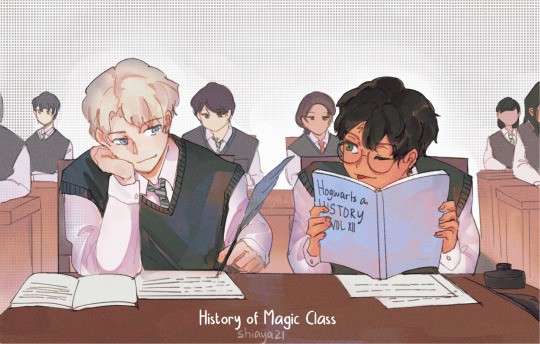
History of Magic Class
Guess who don't pay attention to the class ;)
#drarry#digital art#artists on tumblr#harry potter#fanart#draco x harry#drarry fanart#digital drawing#draco malfoy#draco lucius malfoy#history of magic#cuties in love
430 notes
·
View notes
Text
Wolfstar kiss head cannon
As we all know, history of Magic is the most boring class at Hogwarts so Sirius never pays any attention (except on full moons so he can take notes for Remus)
He usually spends his time in class styling his hair; like french braiding, etc. When he's finished whatever style he has done he will turn to Remus and ask him how it looks
In the beginning Remus tries to ignore Sirius but soon he's giving Sirius whispered compliments and feedback.
Pretty soon he's even giving Sirius directions when Sirius is doing his hair because he doesn't have a mirror
After a while Sirius starts to wonder why Remus puts up with his constant interruptions to class when he's normally so serious about his studies
But what Sirius doesn't know is that Remus finds Sirius playing with his hair is extremely attractive (although he finds everything Sirius does extremely attractive) though he would never say that to Sirius and risk ruining their friendship
What Remus doesn't know is that Sirius' hairstyling might not be entirely boredom, its also a bit of a ploy for Remus' attention because Sirius is also super into Remus
And so one day Sirius has done his hair up in this beautiful braided look and turns to show Remus except Remus is already staring at him and both boys start blushing
Then Remus notices that a strand of Sirius' hair has come loose so he reaches out and tucks it behind his ear without thinking
Now both boys are blushing hard and Remus is still holding Sirius' face in his hand
And neither boy is sure who makes the first move but suddenly they're full on making out in the middle of history of magic
They're only broken apart by James whistling and grinning like a lunatic which finally gets professor Binns' attention.
Sirius and Remus get detention for a week for disturbing the class but it's totally worth it.
#james potter#sirius black#remus lupin#wolfstar#remus x sirius#kisses#gay kiss#harry potter#marauders#headcanon#hc#wolfstar headcanon#wolfstar fluff#first kiss#history of magic#professor binns#hp fandom#hogwarts
83 notes
·
View notes
Text
History of Magic window
It's me! Back again with some harebrained theory about the most minute detail in this game!
And this time we are looking at the stained glass window in the History of Magic classroom:

First of all, the obvious, what the 3 panels of the window represent (from right to left):
The first one is obviously the Hogwarts Founders, all holding or wearing their relic (cup, diadem, sword, locket). For a long while I wondered what that weird shape in the circle at the bottom was. I have since come to the conclusion that this represents the sorting hat (??). It is vaguely hat shaped and has the colors of the 4 houses. But honestly, I'm not sure. If anybody knows please tell me!
The second one is Merlin, it says so at the bottom.
The third one represents the International Warlock Convention of 1289. This is actually an easter egg. In Harry Potter and the Chamber of Secrets, chapter 9, Hermione interrupts Prof. Binns when he's in the middle of a lecture on the International Warlock Convention of 1289 to ask him about the chamber of secrets. The only thing we know about that convention is that a subcommittee of Sardinian sorcerers is involved (the exact quote from Binns is : "In September of that year, a subcommittee of Sardinian sorcerers -" and then Hermione interupts him again to ask another question 😂)
Apart from what is represented on it, what is remarkable about his window imo is that the flow of time is represented from right to left (the Founders came before Merlin, who came before 1289). In western culture, conventionally, time is represented from left to right, because that's the order in which you would naturally read. Also I think it's a convention for stained glass windows in churches to be read from left to right and bottom to top. But the 3 panels here are backwards.
Another thing remarkable to me is that there is very little in common between these 3 panels. Obviously the central figures represented are all different but, also, the embellishments and decorative elements placed around the central figures are all different.
For the panel about the Warlock Convention of 1289, the theme is time, with several hourglasses being represented. (The red hourglass creeps me out a bit because of the red drop you see falling makes me think of blood, like the passage of time is measured by the blood spilt...but anyway!)
For the Merlin's panel the theme is astrological, with the phases of the moon and stars. For the Founder's panel the theme is learning (with a book) and the Hog of Hogwarts. Very little ties the 3 panels together. Except one thing.
The way I see it, there is only one thing in common between those 3 panels and that's the rolled parchment that the International Warlocks are writing on, and that Merlin and Rowena are holding.
And if you look only at that scroll and nothing else, you would naturally infer that the 3 panels might tell the story of this scroll: in the first panel on the left the scroll is being written, then Merlin hold it and has his wand directed at it, like he is applying magic to it, or otherwise doing something to it. And then Rowena is just holding it. That would be the natural way to read the window: left to right and bottom to top. Except we know from the context that this is impossible since time flows in the other direction.

So I wonder if there is a secret message in that window, that you should read from left to right and bottom to top (like you should normally read a stained glass window), that speaks about whatever law was passed at the International Warlock Convention of 1289 and how it relates to Merlin and the Founders.
We don't know much about the Warlock Convention. The only other tidbit I could find is that Ron tells Harry in the first book that dragon breeding was outlawed by the Warlock Convention of 1709 so we can deduct that this convention passes important laws for the worldwide wizarding community. Which law did they vote in 1289?
(Or maybe I'm just being crazy and reading too much into things!)
#hogwarts legacy#hogwarts legacy analysis#hogwarts founders#merlin#warlock convention of 1289#warlock convention#stained glass window#history of magic#rowena ravenclaw
28 notes
·
View notes
Note
Hi, weird question maybe, I'm just some guy who stumbled on your quora answers and figured you're pretty knowledgeable. I'm Italian and I'm wondering if you knew of any forms of magic that could be compared to what in Italy is referred to as 'low ceremonial magic', usually practiced by farmers / poor people. I'm looking for similar traditions in other parts of the world because I'm trying to figure out what kind of magic is most practiced by low income people historically. Thanks a lot
Great question! I'm still in the process of learning about "low magic" or "folk magic." I usually call it folk magic, to distinguish it from ceremonial magic, although the lines between the two are pretty thin and there's significant overlap. (The difference seems to be mainly a class distinction.) If you want to research it, I recommend using "folk magic" as your keyword.
My own country, the United States, has several robust traditions of folk magic that tend to go unnoticed by people who aren't in contact with them. Appalachian Magic is one of the big ones, and Southern Conjure is another one of the big ones. New England has its own variant of English "cunning." Hoodoo and Rootwork are both African diasporic traditions, based in Vodou and practiced mainly in the South. There's also "Pow-Wow," which is mainly Pensylvannia Dutch, Curanderismo and Brujeria (Hispanic), various magical traditions that stem from indigenous religions, and the extremely popular New Age variant of folk magic (which is apparently called "manifesting"). I'm not intimately familiar with all of these systems, but I highly recommend reading New World Witchery by Cory Thomas Hutcheson for a primer on North American folk magic.
The one I know the most about is English "cunning." I just did a project for which I translated part of Bald's Leechbook, a medieval book of herbal remedies written in Old English that was intermixed with some folk spells. I've observed that folk magic tends to be very Catholic, or Catholic-syncretic, because Catholicism has a lot of folk-magic stuff built right into it (like saints' medallions and votive offerings) that were intentionally rooted out of Protestantism. But hey, new folk traditions are always popping up all the time. Tarot cards are only about two hundred years old, but they're a valid and effective divination method, and you can find them in any mainstream bookstore these days.
Finally, I feel the need to say that folk magic is very dark. There's a common idea, mainly in New Age and neopagan circles, that your spells will rebound on you if they're unethical. This has no historical grounding. Curses, forceful love spells, bindings, and other baneful spells are really common. Frequently, magic was the only source of power or agency for people with no other options. Sanitizing folk magic does it a disservice. That doesn't mean that you have to practice baneful magic, only that you should understand why it exists and respect it.
#folk magic#folk witchcraft#witchblr#witchcraft#history of magic#occultism#occult#folklore#folk spellcraft
17 notes
·
View notes
Text
Two very bored Ravenclaws

🦅🦅
#hogwarts legacy#ravenclaw#andrewlarson#andrew larson#hogwarts legacy andrew#amitthakkar#amit thakkar#history of magic
9 notes
·
View notes
Text


Harry Potter book series and Hogwarts study books. I remade it and now its looks good! 17 swatches
DOWNLOAD FREE BOOSTY | SFS
UPDATED! SFS BOOSTY
@simder-talia-blog
#sims 4 cc#sims 4 custom content#sims4#ts4cc#ts4 download#ts4 witchy content#ts4 harry potter#harry potter#fantastic beasts#the tales of Beedle the bard#hogwarts#unfogging the future#magical theory#magical drafts and potions#history of magic#history of hogwarts#the standart book of spells#simblreen
197 notes
·
View notes
Text
Forget Me Not (Severus Snape x OC)
Chapter 1: The Feast



Summary:
Shortly after Theda Desmond replaces Professor Binns as Hogwarts' new History of Magic teacher, she learns that she possesses a rare talent known only to the legendary Altier family, former founders of the French Ministry of Magic who mysteriously went missing over 200 years ago. As she works to uncover the secrets of her curious origins, she develops an unlikely bond with the brooding Potions master, Severus Snape. As their friendship grows, the two begin to recognize that they share a common pain that few have experienced. Will their unique ability to understand each other set them on a course toward healing and new beginnings, or will the ghosts of the past return to tear them apart?
*****
Our story begins at the beginning of Chamber of Secrets and will stick very closely to the canon timeline. While the nature of this story wanes between humorous and romantic, it is also, in many ways, a story about the non-linear nature of grief. This is my first fanfic, so I hope you enjoy it.
Warnings: brief allusions to struggles with body image. Future chapters will contain some smut, discussion of death and suicide, as well as non-sexual abuse.
Excerpt:
“It’s nice to meet you, Professor Snape.”
He said nothing as he continued slowly skewering small pieces of food onto his fork.
"May I ask which subject you teach?"
"Potions." He said, his tone sounding slightly pointed.
"You know, you are the only teacher at this table I envy," Theda said, enthusiastically. "Potions was always my favorite subject when I was in school."
"Perhaps you should teach it, then," He replied in a monotone voice, still not meeting her gaze.
Unsure if he was being sarcastic or not, Theda chose to ignore the comment.
"Actually, I am quite happy to be teaching History of Magic. That was my second favorite subject in school, and I feel like I could genuinely get the students to take an interest in it. I hope so, anyways."
"Hmph," he muttered. "Good luck getting any of these thick-skulled children to take an interest in anything that doesn't involve flying around on a broomstick or foolishly waving their wands about in the air."
"Well, we shall see." She said, smiling. "Even if I get one kid to take an interest in the subject, I'll count that as a victory." 
"Yes, well... You'll soon find that these children are practically unteachable."
She said nothing, unsure how to respond.
"Still... I do hope you succeed in kindling a flame, however small, in at least one of your students."
Continue reading: Wattpad | Ao3
#severus snape#severus snape x oc#alan rickman#snape fanfiction#severus snape fanfiction#Snape fanfic#Severus snape fanfic#severus x oc#chamber of secrets#Harry Potter fanfiction#fantastic beasts#oc x canon#canon compliant#snape love#pro severus#history of magic#ravenclaw#ravenclaw oc#metamorphmagus#hogwarts school of witchcraft and wizardry
8 notes
·
View notes
Text



MAKO SONG & AALIS DURAND | HP 1300S
I let the scale tip and feel all of it
It’s uncomfortable but right
We were born to try
To see each other through
To know and love ourselves and others well
Is the most difficult and meaningful
Work we’ll ever do
➔ Nine by Sleeping At Last
@kathrynalicemc
#Merry Christmas! 🎄❤️ Hope you like it!!#not v christmassy but hopefully still a nice surprise 🤔😂#aako#the legend of the portkey#aalis durand#mako song#my gifs#my edits#the song family#the durand family#history of magic#hp history#aalis in the first gir be like ‘damn… he’s hot 🥵’ and she’s right#ancient day romeo and juliet? anyone? I’m way too into this#also it wasn’t the wisest decision to pick a model as a fc … now I’m struggling#and she has to strut towards her lover like she about to kill him or something 😅😅#but let’s just say it’s them keeping up the act 🙈🤓
7 notes
·
View notes
Text

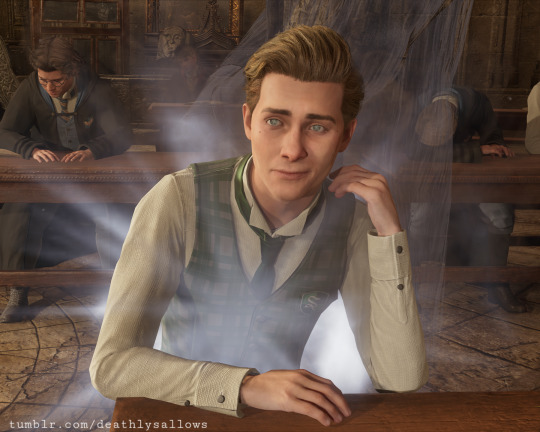

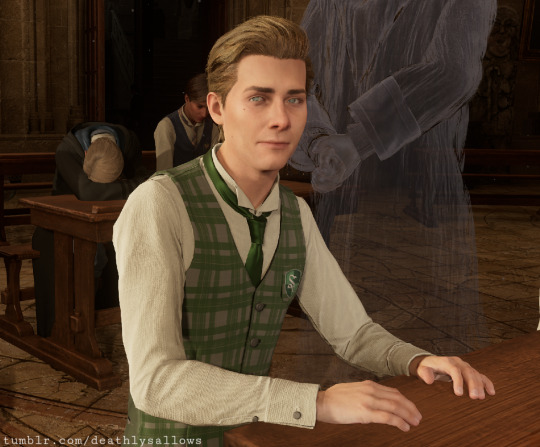
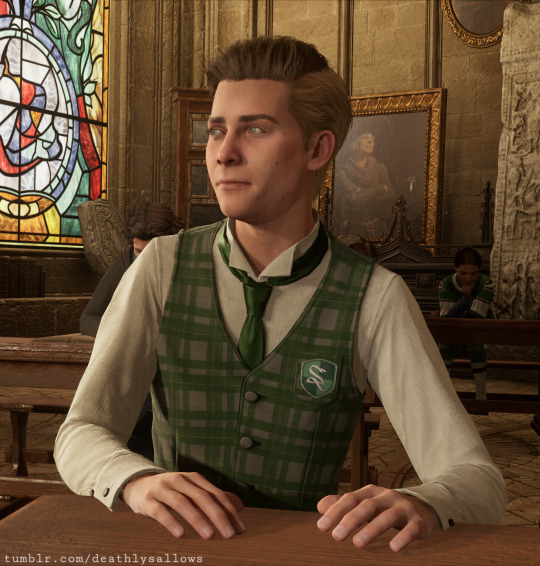
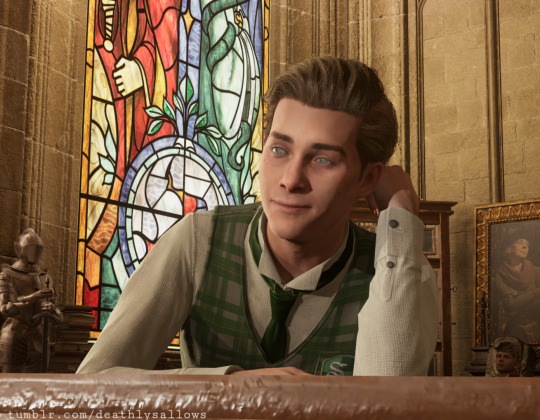

Ominis startled awake by Professor Binns 🤭
#Ominis gaunt#hogwarts legacy#hogwarts legacy screenshots#slytherin#professor binns#history of magic
204 notes
·
View notes